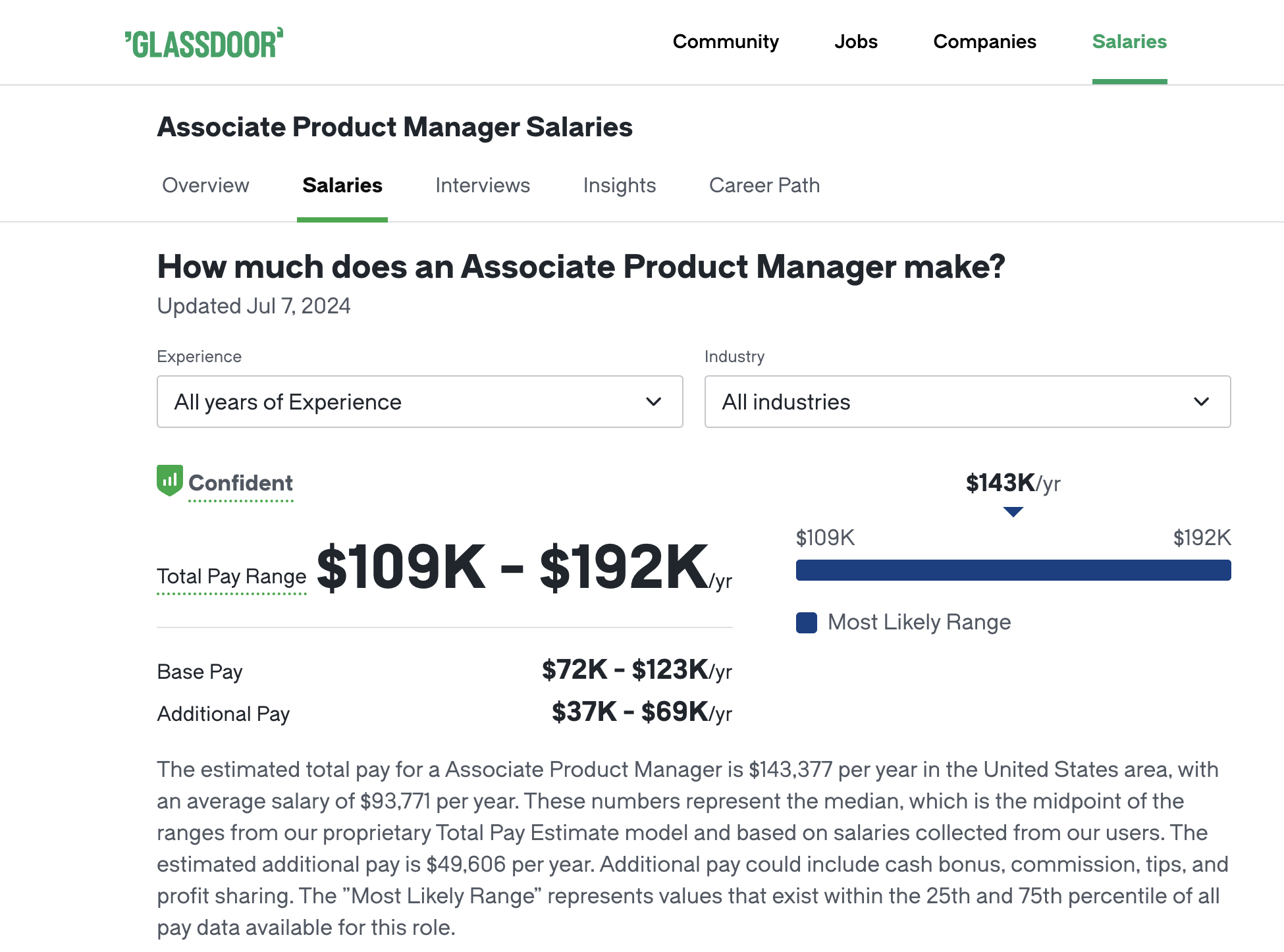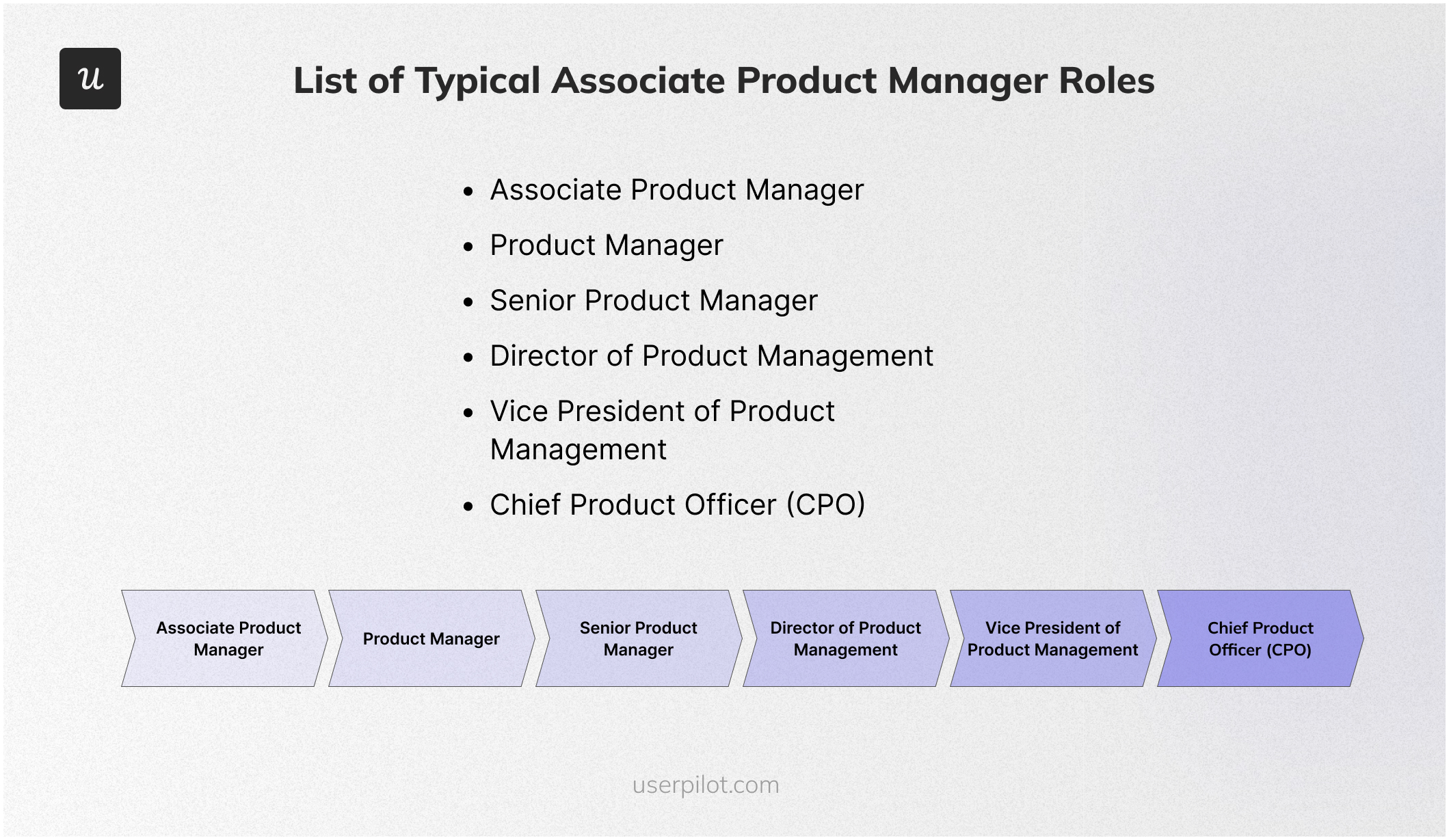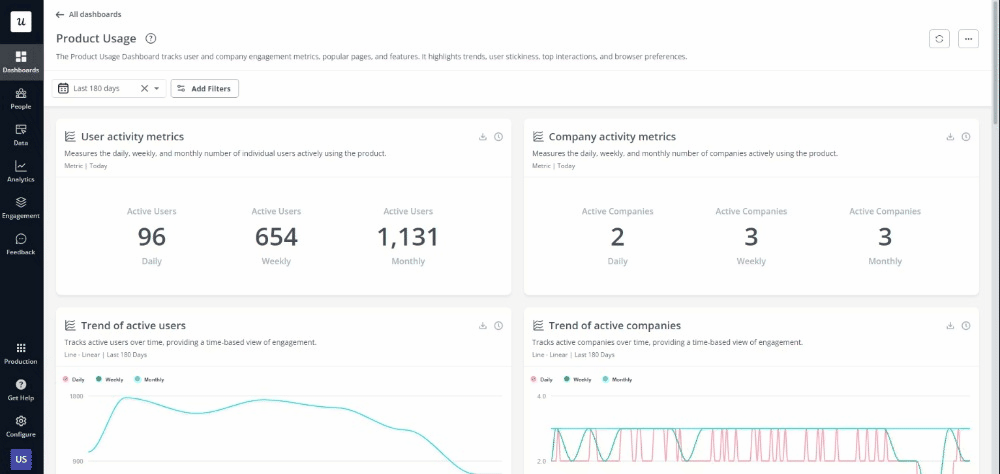
Try Userpilot Now
See Why 1,000+ Teams Choose Userpilot

What is an associate product manager?
An associate product manager, or a junior product manager, is an entry-level position for people who are starting out in product management.
What does an associate product manager do?
Associate Product Managers (APMs) handle smaller projects or contribute to larger ones, working under experienced product managers.
They focus on understanding customer needs, analyzing market trends, and aiding in developing and improving product features.
Their responsibilities include collaborating with engineering, design, and marketing teams, creating user stories, and ensuring product features align with user expectations and business goals.
APMs also track and report on product performance, providing insights into successes and areas for improvement.
Associate product manager’s main responsibilities
As an Associate Product Manager, you play a crucial role in the product lifecycle. Here’s a breakdown of your core responsibilities:
- Product Strategy Development: Assist in crafting and executing product strategies aligned with company goals and market needs. Read more on product strategy.
- Market Research and Analysis: Conduct thorough market research to identify opportunities, customer needs, and competitor activities. Learn how to conduct effective market research.
- Feature Prioritization: Collaborate with senior product managers to prioritize product features and backlog items based on customer feedback and business value. Discover best practices in feature prioritization.
- Cross-functional collaboration: Work closely with engineering, design, and marketing teams to ensure seamless product development and launch processes. Check out strategies for effective collaboration.
- Customer Feedback Integration: Gather and analyze customer feedback to inform product improvements and new feature development. Explore methods for integrating customer feedback.
- Product Roadmap Management: Help create and maintain a detailed product roadmap that aligns with the strategic vision and market demands. Learn more about product roadmapping.
- Data-Driven Decision Making: Use analytics tools to track product performance and user engagement and identify areas for improvement. Leverage insights from data analytics.
- User Experience Optimization: Collaborate with UX/UI designers to ensure the product offers an intuitive and engaging user experience and gain insights into user experience optimization.
- Stakeholder Communication: Regularly update stakeholders on product progress, challenges, and future plans to ensure alignment and support. Learn effective stakeholder communication techniques.
Associate product manager salary
One of the biggest factors influencing your salary is your experience level. Here’s how experience can impact your associate product manager’s salary, according to Glassdoor:
- 1 to 3 years experience: $110,299/year
- 4 to 6 years experience: $112,294/year
- 7 to 9 years experience: $116,557/year
Industries with the highest demand for product professionals tend to pay the most on average. Technology, finance, healthcare, e-commerce, and consumer goods represent a significant portion of product management job openings. The average base salary for an Associate Product Manager in the United States ranges from $113,670 to $142,458, with a median of around $127,319.
Where you live can have a big impact on how much you make as an associate product manager. As more and more companies employ a geographically dispersed workforce (including remote workers), it’s common for companies to offer location-based salaries. According to Glassdoor, these are the midpoint salaries for associate product managers in the following large US cities:
- San Francisco: $123,503/year
- New York: $98,115/year
- Boston: $$94,294/year
- Washington, DC: $96,860/year
- Chicago: $93,181/year

Associate product manager career path
Here is the typical career path for an associate product manager:
- Associate Product Manager: At this initial stage, you’ll work closely with senior product managers to grasp the fundamentals of product lifecycle management. This includes participating in market research, developing product specifications, and managing minor projects. Success in this role is achieved by demonstrating a keen ability to analyze data, understanding customer feedback, and effective communication skills, which are crucial for progressing to more advanced positions.
- Product Manager: Moving up, Product Managers take full responsibility for the success of their products from conception through launch and beyond. This involves more direct involvement in setting product strategy, defining roadmaps, and leading cross-functional teams to execute these plans. To excel, you must continually improve product offerings based on user feedback and performance metrics, enhancing customer satisfaction and business outcomes.
- Senior Product Manager: At the senior level, you’ll oversee multiple product portfolios, mentor junior product managers, and make critical decisions that affect the company’s long-term product strategy. Advancement at this stage is contingent upon your ability to lead and inspire teams, manage complex product challenges, and drive significant growth and innovation within the organization.
- Director of Product Management: As a Director, your focus shifts to a broader product management strategy, including integration of customer insights into product development and alignment with business objectives. The key to success in this role is your capacity to enhance user experience and manage product lines to support the company’s market presence and profitability goals.
- Vice President of Product Management: The VP of Product Management plays a critical role in shaping the company’s product vision at the highest strategic level. Progress in this role depends on your expertise in managing and adapting to market trends, influencing product culture, and making decisions that drive the company forward in competitive and innovative ways.
- Chief Product Officer (CPO): Reaching the pinnacle of the product management career ladder, the CPO is responsible for the company’s entire product strategy. This top executive role demands a visionary approach to product development, a thorough understanding of the market, and the ability to steer the company through shifts in technology and consumer preferences, ensuring sustained business success and market leadership.

Best practices for being a great associate product manager
To excel in this role, here are some best practices that associate product managers should embrace:
- Embrace a data-driven mindset: Leverage analytics and user feedback to make informed decisions about product features, pricing, and roadmaps. Regularly analyze usage metrics and customer insights to identify improvement areas and growth opportunities.
- Stay agile and adaptable: Be prepared to pivot quickly based on market changes, customer needs, and new competitive threats. Embrace an iterative approach to product development, with frequent releases and continuous improvement.
- Prioritize user experience over anything else: Put the user at the center of every decision. Conducted user research, gathered feedback, and tested prototypes to ensure the product was intuitive and engaging and solved real customer problems. Continuously seek ways to enhance the user experience and drive customer satisfaction.
- Develop a growth mindset: Approach product management as a continuous learning process. Stay up-to-date with industry trends, best practices, and emerging technologies. Attend conferences, participate in online communities, and engage with mentors to expand your knowledge and skills. Continuously seek opportunities for professional development and personal growth.
Associate product manager FAQs
- Is an associate product manager a leadership role?
An Associate Product Manager (APM) is typically an entry-level or early-career role in product management. It is not generally considered a leadership role. Instead, APMs work closely with more senior product managers and other stakeholders to learn the ropes of product management.
- What is the salary of an associate product manager?
The estimated total pay for an Associate Product Manager is $143,246 per year in the United States area, with an average salary of $93,706 per year.
- What does an associate product manager do?
Associate Product Managers (APMs) are junior employees who work under experienced product managers and assist them with different tasks such as user research, product performance tracking, or customer feedback analysis.
Conclusion
We hope this guide has provided you with valuable insights into the roles, responsibilities, and rewards associated with this role.
Looking into tools for associate product managers? Userpilot is an all-in-one product platform with engagement features and powerful analytics capabilities. Book a demo to see it in action!








